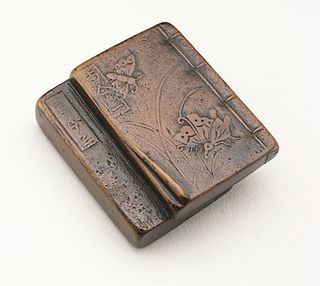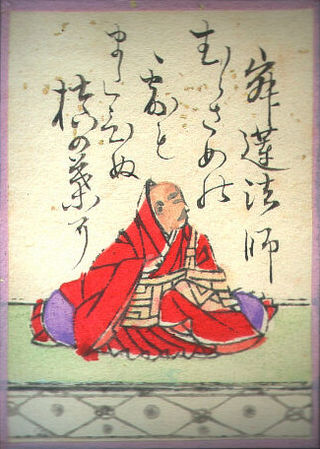The Shin Kokin Wakashū, also known in abbreviated form as the Shin Kokinshū (新古今集) or even conversationally as the Shin Kokin, is the eighth imperial anthology of waka poetry compiled by the Japanese court, beginning with the Kokin Wakashū circa 905 and ending with the Shinshokukokin Wakashū circa 1439. The name can be literally translated as "New Collection of Ancient and Modern Poems" and bears an intentional resemblance to that of the first anthology. Together with the Man'yōshū and the Kokinshū, the Shin Kokinshū is widely considered to be one of the three most influential poetic anthologies in Japanese literary history. It was commissioned in 1201 by the retired emperor Go-Toba, who established a new Bureau of Poetry at his Nijō palace with eleven Fellows, headed by Fujiwara no Yoshitsune, for the purpose of conducting poetry contests and compiling the anthology. Despite its emphasis on contemporary poets, the Shin Kokinshū covered a broader range of poetic ages than the Kokinshū, including ancient poems that the editors of the first anthology had deliberately excluded. It was officially presented in 1205, on the 300th anniversary of the completion of the Kokinshū.

Japanese poetry is poetry typical of Japan, or written, spoken, or chanted in the Japanese language, which includes Old Japanese, Early Middle Japanese, Late Middle Japanese, and Modern Japanese, as well as poetry in Japan which was written in the Chinese language or ryūka from the Okinawa Islands: it is possible to make a more accurate distinction between Japanese poetry written in Japan or by Japanese people in other languages versus that written in the Japanese language by speaking of Japanese-language poetry. Much of the literary record of Japanese poetry begins when Japanese poets encountered Chinese poetry during the Tang dynasty. Under the influence of the Chinese poets of this era Japanese began to compose poetry in Chinese kanshi); and, as part of this tradition, poetry in Japan tended to be intimately associated with pictorial painting, partly because of the influence of Chinese arts, and the tradition of the use of ink and brush for both writing and drawing. It took several hundred years to digest the foreign impact and make it an integral part of Japanese culture and to merge this kanshi poetry into a Japanese language literary tradition, and then later to develop the diversity of unique poetic forms of native poetry, such as waka, haikai, and other more Japanese poetic specialties. For example, in the Tale of Genji both kanshi and waka are frequently mentioned. The history of Japanese poetry goes from an early semi-historical/mythological phase, through the early Old Japanese literature inclusions, just before the Nara period, the Nara period itself, the Heian period, the Kamakura period, and so on, up through the poetically important Edo period and modern times; however, the history of poetry often is different from socio-political history.

Fujiwara no Sadaie (藤原定家), better-known as Fujiwara no Teika, was a Japanese anthologist, calligrapher, literary critic, novelist, poet, and scribe of the late Heian and early Kamakura periods. His influence was enormous, and he is counted as among the greatest of Japanese poets, and perhaps the greatest master of the waka form – an ancient poetic form consisting of five lines with a total of 31 syllables.

Fujiwara no Shunzei was a Japanese poet, courtier, and Buddhist monk of the late Heian period. He was also known as Fujiwara no Toshinari or Shakua (釈阿) and when younger (1123–67) as Akihiro (顕広). He was noted for his innovations in the waka poetic form and compiling the Senzai Wakashū, the seventh imperial anthology of waka poetry.
The Kin'yō Wakashū, sometimes abbreviated as Kin'yōshū, is the fifth Japanese imperial anthology of waka whose two drafts were finished in 1124 and 1127. It was compiled at the behest of the Retired Emperor Shirakawa, by Minamoto no Shunrai It consists of ten volumes containing 716 poems.
The Rokujō family (六條家) was a poetically conservative faction in the Japanese Imperial court, founded by Fujiwara no Akisue ; it was the first clan to specialize in attaining power and influence via success in poetry, and was originally opposed to their opposite numbers amongst the Minamoto clan, although later they would be opposed to a more junior branch of the old and puissant Fujiwara family, as represented by Fujiwara no Shunzei and his son, Fujiwara no Teika. It was also known for, besides its conservative views on the composition of poetry, the quality of its scholar's work on old poetry. One of the Rokujō—Fujiwara no Akisuke (1090–1155)—compiled the Imperial anthology, the Shika Wakashū.
Years link to the corresponding "[year] in poetry" articles.
This page is part of the List of years in poetry. The List of years in poetry and List of years in literature provide snapshots of developments in poetry and literature worldwide in a given year, decade or century, and allow easy access to a wide range of Wikipedia articles about movements, writers, works and developments in any timeframe. Please help to build these lists by adding and updating entries as you use them. You can access pages for individual years within the century through the navigational template at the bottom of this page, and you can access pages for other centuries through the navigational template to the right. To access the poetry pages by way of a single chart, please see the Centuries in poetry page or the List of years in poetry page.
Years link to corresponding "[year] in poetry" articles.

Jakuren (寂蓮) (1139–1202) was a Japanese Buddhist priest and poet. He was adopted by the noted poet Fujiwara no Shunzei upon the death of Shunzei's younger brother. Shunzei originally intended for Sadanaga to be his heir; however, he subsequently had two male offspring of his own, and Sadanaga was forced to step aside in favor of Fujiwara no Sadaie. As was common practice at the time, he became a monk, and acquired the religious name of Jakuren. Taking Saigyo as his model, he traveled around the country, composing poems of his travels. He was well regarded in his time and frequently associated with Fujiwara no Teika. He was one of the six compilers of the eighth imperial waka anthology, the famous Shin Kokin Wakashū, and thirty-five of his poems were selected for the work. Before he died, he adopted Fujiwara no Ietaka, pupil to Shunzei. One of his poems was included in the famous poetry anthology Hyakunin Isshu.

Waka is a type of poetry in classical Japanese literature. Although waka in modern Japanese is written as 和歌, in the past it was also written as 倭歌, and a variant name is yamato-uta (大和歌).

Fujiwara no Kiyosuke was a Japanese waka poet and poetry scholar of the late Heian period.

Asukai Masatsune was a Japanese waka poet of the early Kamakura period. He was also an accomplished kemari player. and one of his poems was included in the Ogura Hyakunin Isshu.
Minamoto no Michitomo was a waka poet and Japanese nobleman active in the early Kamakura period. He was the son of Minamoto no Michichika and the foster father of the monk Dōgen. He is designated as a member of the New Thirty-Six Immortals of Poetry. He is also known as Horikawa Michitomo and Horikawa Dainagon (堀川大納言).
The Un'yō Wakashū (雲葉和歌集) is a Japanese waka anthology compiled by Kujō Motoie in the Kamakura period. Only eleven of a presumed twenty volumes have survived.






